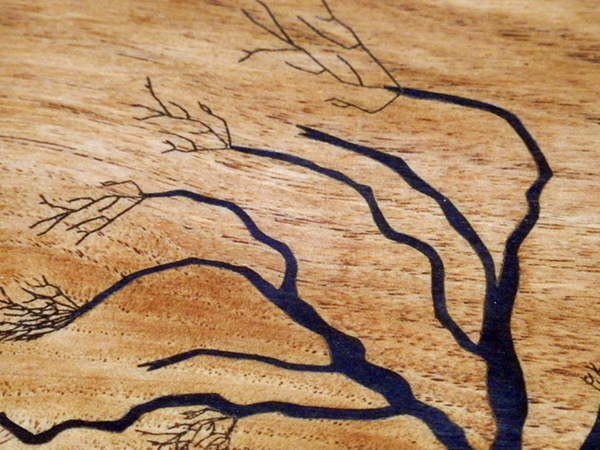After The Storm Exhibition
In 2016 Digby Morrow was selected as one of twelve furniture makers to design and make a piece to be exhibited at the Royal Botanic Garden Edinburgh. The exhibition was titled “AFTER THE STORM” and ran for six months until May 2017.
The concept was one of regeneration with timber salvaged from the disaster of Cyclone Andrea in 2012 being transformed into beautiful objects. Digby was given a plank of Sweet Chestnut and set about designing and making a jewellery box the process of doing so being an act of regeneration from disaster. In parallel he produced detailed inlays and made innovative use of wood grain and colours to depict the storm and the subsequent natural recovery.
A threatened tree is inlaid in black on the outside of the box stripped of its leaves as it struggles against the violence of the Storm. The sweet chestnut grain swirls around like the wind.
The outside of the box betrays little of the re-awakening to come.
On opening the box, the green of Spring is here, with an inlaid wren carrying twigs in its beak for nesting and a decorative “circle of life” with green leaves representing the natural process of selfseeding and regeneration.
*With personal thanks to Royal Botanic Garden Edinburgh & Forestry Commission Scotland





Strawberry Field Project
A ground-breaking ceremony was held on 31st July, 2018 at the site of Strawberry Field, a former Salvation Army children’s home in Liverpool. The site was the inspiration for the classic 1967 Beatles song “Strawberry Fields”.
The facility will be a centre of vocational-training and work-placement for young people with learning disabilities.
The re-developed Strawberry Field is expected to open in 2019. As well as its youngster support activities the site will incorporate a visitor attraction which will relate the story of a young John Lennon’s frequent visits to play with the youngsters who lived in Strawberry Field.
The Salvation Army commissioned Digby Morrow to make the box to be used as a time capsule to house various memorabilia.

